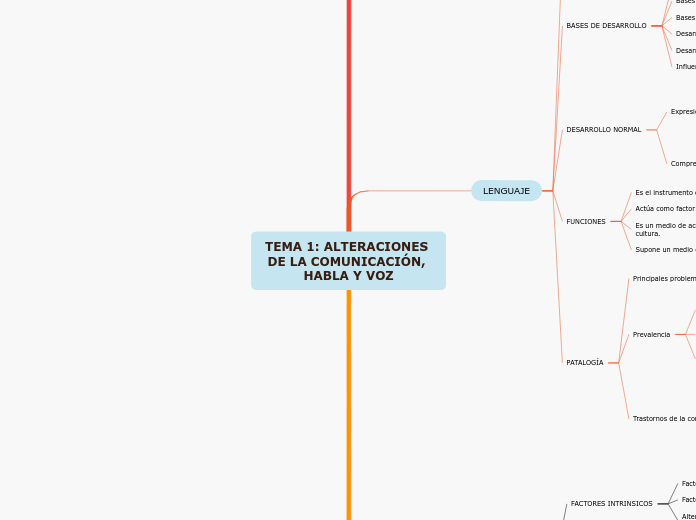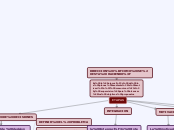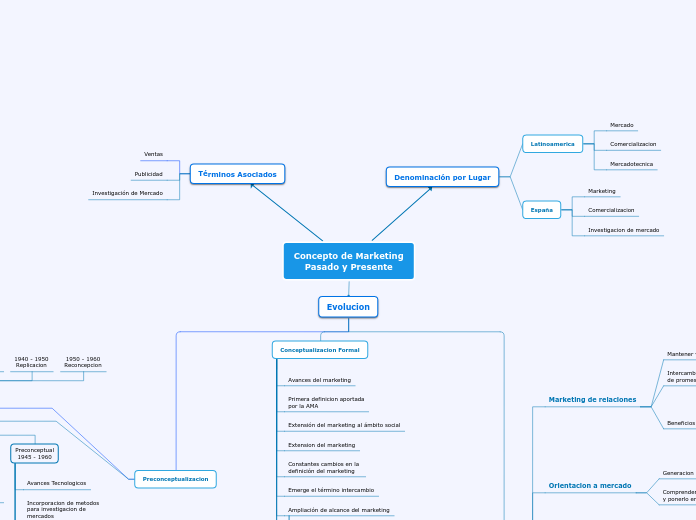TEMA 1: ALTERACIONES DE LA COMUNICACIÓN, HABLA Y VOZ
To name your story, you have to think about the overall message and what you want your audience to understand from the story. Also, make it relevant and easy to remember.
ETIOLOGIA
COMBINACION DE AMBOS FACTORES
FACTORES AMBIENTALES
Entornos familiares patológicos
Ambientes sobreprotectores
Experiencias comunicativas muy
pobres los primeros años de vida
Hacen referencia a los contextos
situacionales e interpersonales
FACTORES INTRINSICOS
Alteraciones en los dispositivos específicos de procesamiento lingüístico y/o almacenamiento de la información.
Factores de tipo cognitivo o intelectual
Factores orgánicos que afectan al funcionamiento sensorial, motor y neurológico.
LENGUAJE
The middle of the story is where you add layers of complications that will lead to the end. Reveal more about the character's journey. Did their personality go through changes? How did they overcome the challenges? And as you build up the story’s central conflict, make it more personal to that character. Also, from the middle act, you have to lead into the final act.
PATALOGÍA
Trastornos de la comunicación
Trastorno de la comunicación no especificado
Trastorno de la comunicación social
Trastorno de la fluidez (tartamudez) de inicio en la infancia
Trastorno de los sonidos del habla (T.S.H.)
Prevalencia
Este porcentaje va disminuyendo a medida que
se incrementa la edad.
Mayor porcentaje de problemas de
lenguaje en niños pequeños.
Mayor prevalencia en niños
que en niñas.
Principales problemas
Trastorno del lenguaje
Retraso del lenguaje
FUNCIONES
Supone un medio de identificación con iguales.
Es un medio de acceder a la información y a la cultura.
Actúa como factor regulador de la conducta.
Es el instrumento que da forma al pensamiento.
DESARROLLO NORMAL
There wouldn't be any tension and excitement in your story if there weren't any obstacles in your character's way.
Comprensión
Expresión
A story is nothing more than a character overcoming a series of difficulties to reach the desired goal. Obstacles usually create suspense and conflict. In overcoming obstacles, there is growth: weak becomes strong; hatred turns into love; sadness into happiness; wrong into right; lies into truth; or evil becomes good.
See a few examples below:
- stopping a meteor
- finding a killer
- finding love
Nivel pragmático
Nivel semántico
Nivel morfosintáctico
Nivel fonológico
BASES DE DESARROLLO
Your character(s) need(s) motivation in order to solve the challenge(s).
Influencia del medio
Desarrollo afectivo, emocional y social
Desarrollo cognitivo
Bases anatómicas y funcionales
Secondary characters also might have motivs beacuse of which they may cross path with main character or which might trigger them to help the main character.
Bases sensoriales
Secondary characters might also have motives that lead them to cross paths with the main character or which might trigger them to help the main character.
Bases neurofisiológicas
Why does your character need to confront this challenge? What does he/she expect to accomplish by solving it?
See a few examples:
- will marry in 3 days
- can fix the mistakes of the past
DEFINICIÓN
Each story has a main character and that character usually needs to solve a problem or challenge. The character's challenge is the one that creates tension throughout the story.
Permite al hombre hacer explícitas las intenciones, estabilizarlas, convertirlas en regulaciones muy complejas de acción humana y acceder a un plano positivo de autorregulación cognitiva y comportamental, al que no es posible llegar sin lenguaje.
Type in any other challenges which other characters in the story need to face.
Una característica específicamente humana que desempeña importantes funciones a
nivel cognitivo, social y de comunicación;
COMUNICACIÓN
In the beginning of the story (or the exposition), you will need to introduce the setting and characters. You might also want to introduce the main conflict. This part of the story is important because it gives the reader necessary background information and maybe even a first insight into a character’s personality.
Subtopic
ÁREAS DE INTERVENCIÓN
The setting (time & place) of a story can change throughout the plot.
Comunicación verbal
Sensory details include sight, sound, touch, smell, and taste. These details are important because they create depth in your setting.
See a few examples below:
- the smell of fresh bread
- the scent of freshly cut grass
- rain falling onto the windshield etc.
Tipo de comunicación en la que se
utilizan signos lingüísticos en el mensaje
Comunicación escrita
Comunicación oral
Comunicación no verbal
Your story can take place wherever your imagination will take you to.
For example: in an elevator, in an enchanted forest, etc. Don't forget to give details of the environment each time the setting changes, otherwise, the story can be confusing. Also, mention the seasons as each of them has unique weather and events.
Dotarle de instrumentos para comunicarse
Desarrollar la capacidad comunicativa
expresiva y comprensiva
Potenciar el lenguaje a través del cuerpo
Crear la necesidades de comunicarse con los
niños
EVALUACIÓN
Funciones prágmaticas
Función personal.
Utiliza el lenguaje para imaginar.
Hace preguntas.
Transmite información.
Consigue llamar la atención del interlocutor.
Expresa deseos.
Interactúa con personas (con y sin objetos intermediario).
Prerequisitos
Memoria
Comprensión simbólica
Discriminación
Imitación
Atención
Forma
Oral y Gestual
Gestual
Oral
COMPONENTES
Characters are essential to a good story. Usually, the protagonist(s) is/are the most affected by the plot. Introduce a character by focusing on their actions, interests, and occupation, as the physical appearance doesn't make a difference in most cases.
Contexto
Vía de transmisión
Código
Mensaje
Receptor
Emisor










